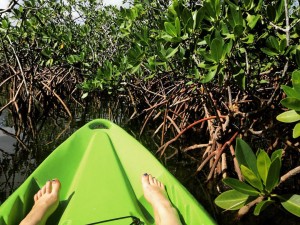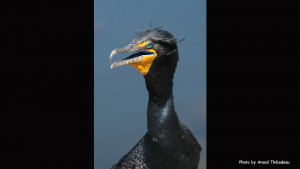
Kayaking through Biscayne mangroves
HOMESTEAD, Fla. — I haven’t been kayaking since I was 10 years old, when my family went on a road trip in which our first stop was a visit to Brevard Zoo in Central Florida. The zoo offers guided kayak tours that give guests an up-close view of the wildlife. As a family of five, with myself as the oldest child, my brother shared a kayak with my father and my sister shared a kayak with my mother. I kayaked alone.
Suffice it to say I did not enjoy my time kayaking. My scrawny arms strained to push the paddles against the water, while I tried desperately to figure out the right technique to make my kayak move straight forward. From that one experience, and in the 10 years since, I have declined accompanying my father when he wanted to go trekking through the waters in our kayak.
The first time I have ventured into the water since was on my recent trip to Biscayne National Park’s Convoy Point for a trip kayaking through the mangroves with my father.
Biscayne National Park is located near here and is unique in its landscape when compared to other national parks. It is composed mostly of open water, so unless you own something like a kayak or a small boat, it is not very navigable. At this point in time, the park does not rent watercraft to visitors to assist those who do not own any to explore the park’s waters.
According to Park Ranger Gary Bremen, however, the park plans to offer boat rentals in the future.
“[Kayaking is] pretty popular,” said Bremen. “It would be more popular if we had people renting boats out. From Convoy point there is kayaking along the shoreline. It’s the easiest place to get to.”
 |
Kayaking into the mangroves near Convoy Point at Biscayne National Park (Photo by Diana Rodon). |
I found the huge expanse of open water intimidating until we took off in our lime-green kayak. The waters were shallow, only about a foot deep. The shallow water did not mean I was any better at kayaking then I was at age 10. I had to relearn how to hold my paddles and which way to face them. And I learned for the first time how to kayak with another person by timing your own movements with the other person’s.
My father instructed me on how to face my paddles in just the right position. He timed his paddle movements with my own sporadic ones. After gaining my footing, navigating the waters became relatively easy, even fun. I loved the feeling of water splashing onto my legs in the hot sun as I lifted and pushed the paddle back down into the water.
I, by no means, became an expert that quickly, though. Upon finding the first opening of the mangroves, we decided to travel down that path. When the strip of water became particularly narrow or the waves picked up slightly, I would often crash into the branches. We reached a dead end in the path and turning the kayak around resulted in more angles than a three-point turn. We hit the “curb” multiple times.
Kayaking through the mangroves was surprisingly serene. I did not have many expectations for this trip. I thought I might see a lurking alligator or one of the many lionfish that have made Biscayne Bay their home. I didn’t see any of these; I barely saw much wildlife at all.
The most wildlife I saw were the birds hanging out in the twisting branches of the mangroves and a few small fish in the water. There were many schools of minnows around but not much else although my father claimed to have spotted a barracuda.
| A cormorant, one of the many birds who make their home among the Biscayne Bay mangroves (Photo courtesy of the National Park Service). |  |
Ibises, great blue herons and great white herons were the most common birds I saw. They usually were found close to the water on low hanging branches.
Perhaps the most unique bird I saw was the osprey. I saw a few of them and they never remained in their high branches for very long before swooping down, with outstretched wings, and nearly breaking the water’s surface.
The most difficult part of the kayaking trip was heading back to the launch point. We paddled against the current in far more open water than when we explored the mangroves. Shockingly, our small, strapped on kayak skeg, was able to assist us in moving straight on to our final destination.
Biscayne National Park offers not only a wholly different habitat from other national parks in the U.S., but also a beautiful environment for kayakers of all levels of experience.
If You Go
- Bring your own kayak, paddles, water bottles, sunscreen and life jackets. Be advised that the launch point at Convoy Point is open from 7 a.m. to 5:30 p.m.
- The best time to visit depends on what kayakers are looking for. The waters are calmer from the months of May until November however there are more mosquitoes and a higher probability of lightning strikes. The winter months have less bugs but the waters are rougher due to high wind.
- Directions: 9700 SW 328th St., Homestead, Fla. 33033. Take Florida state route 874 South and Ronald Reagan Turnpike to SW 137th Avenue in Princeton. Take exit six from Ronald Reagan Turnpike. Turn left onto SW 137th Avenue. Turn left onto 328th Street/North Canal Drive. Turn left at Biscayne Trail. Continue on and arrive at destination.
- For more information: http://www.nps.gov/bisc/index.htm

Comments are Closed